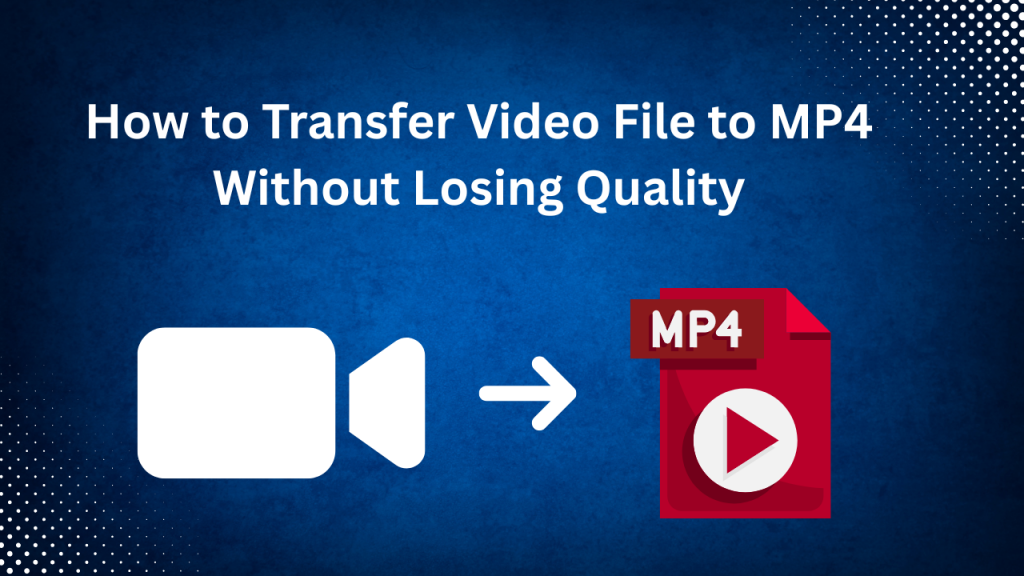Videos are one of the most popular forms of digital content today. From social media posts to online classes and business presentations, video plays a huge role in communication. However, not all video formats are universally supported. Some files may not open on certain devices or platforms, and others may be too large to share easily. This is where learning how to transfer video to MP4 without losing quality becomes important.
The MP4 format is widely recognised as the most compatible and efficient video format available. By converting or changing a video to MP4, you ensure smooth playback, easy sharing, and smaller file sizes, all without losing video quality.
In this article, we’ll explore why MP4 is the preferred choice, the best methods to transfer or change video files to MP4, and step-by-step instructions using both manual and automated tools.
Why Choose MP4 Format?
Before you start the process to transfer a video to MP4, it’s important to understand why this format is so popular.
- Universal Compatibility – MP4 is supported on Windows, Mac, Android, iOS, Smart TVs, and almost every media player.
- Efficient Compression – It uses modern codecs like H.264 or H.265, which compress files without losing much quality.
- Streaming-Friendly – MP4 is optimised for online streaming platforms like YouTube, Facebook, and Instagram.
- Smaller File Size – Compared to older formats such as AVI or MPEG, MP4 offers excellent quality in a smaller file size.
This makes MP4 the best choice when you want to convert video to MP4 for sharing, uploading, or archiving.
Different Ways to Transfer Video to MP4
There are several approaches to change video to MP4, each with its pros and cons. Let’s explore them in detail.
1. Using Media Players (VLC Method)
The popular VLC Media Player can also transfer videos to MP4. It’s free and works across different operating systems.
Steps to use:
- Open VLC Media Player.
- Go to Media > Convert/Save.
- Add the video file you want to convert.
- Choose MP4 as the output format.
- Set the destination folder and click Start.
2. Using Online Converters
If you’re working with a small video file and don’t want to install software, online converters are an option. Websites like Clideo, FreeConvert, or Convertio allow you to upload your video and change it to MP4 instantly.
However, they do come with limitations:
- File size restrictions (usually 100MB–500MB free limits).
- Slower processing times depending on internet speed.
- Potential privacy risks if you’re uploading personal or sensitive videos.
For small, casual projects, they’re convenient, but for larger files or frequent conversions, desktop tools are more reliable.
3. Using the Self-Operating Tool
The most reliable way to transfer video to MP4 without losing quality. They provide full control over output formats, resolution, bitrate, and file size. One of the best tools available is SysTools Video Converter, which allows you to:
- Change videos into multiple formats, like convert video to MOV, MKV, AVI, and more.
- Perform batch conversions to save time when working with multiple files.
- Customise resolution, bitrate, and codecs to balance quality and file size.
- Trim unwanted parts before conversion to reduce file size further.
- Ensure that video quality remains high after conversion.
This makes it a preferred solution for anyone looking to change video to MP4 quickly and effectively.
Step-by-Step: Transfer Video File to MP4
Here’s a simple guide on how you can use SysTools to change videos to MP4 without losing quality:
- Download and install the Proactive software on your system.
- Add your video files – you can upload one file or multiple files for batch conversion.
- Choose the MP4 as the desired output format.
- Start the conversion process and wait until the tool finishes processing.
- Save the converted MP4 file to your preferred location.
The entire process is quick, efficient, and ensures that your videos remain clear and professional-looking.
Common Mistakes to Avoid
While converting videos, users often make mistakes that can result in poor output:
- Over-compressing – Leads to blurry or pixelated visuals.
- Choosing unnecessarily low resolution – Reducing 1080p videos to 360p may save space, but ruins quality.
- Using unreliable tools – Some free converters add watermarks or lower the quality significantly.
Avoiding these mistakes ensures your MP4 files look just as good as the originals.
Conclusion
In this article, we’ve explored how you can effectively transfer video to mp4 file format using various manual and automated methods without affecting the quality of video. If someone wants a reliable, trusted, secure tool, then we’ve recommended the software above, so by following the right methods and best practices, you can confidently change your videos to MP4 format, which is ready to share, upload, or archive without worrying about size or compatibility issues.



